YAMAHA GRIZZLY 550 2014 Owners Manual
Manufacturer: YAMAHA, Model Year: 2014, Model line: GRIZZLY 550, Model: YAMAHA GRIZZLY 550 2014Pages: 174, PDF Size: 4.2 MB
Page 141 of 174
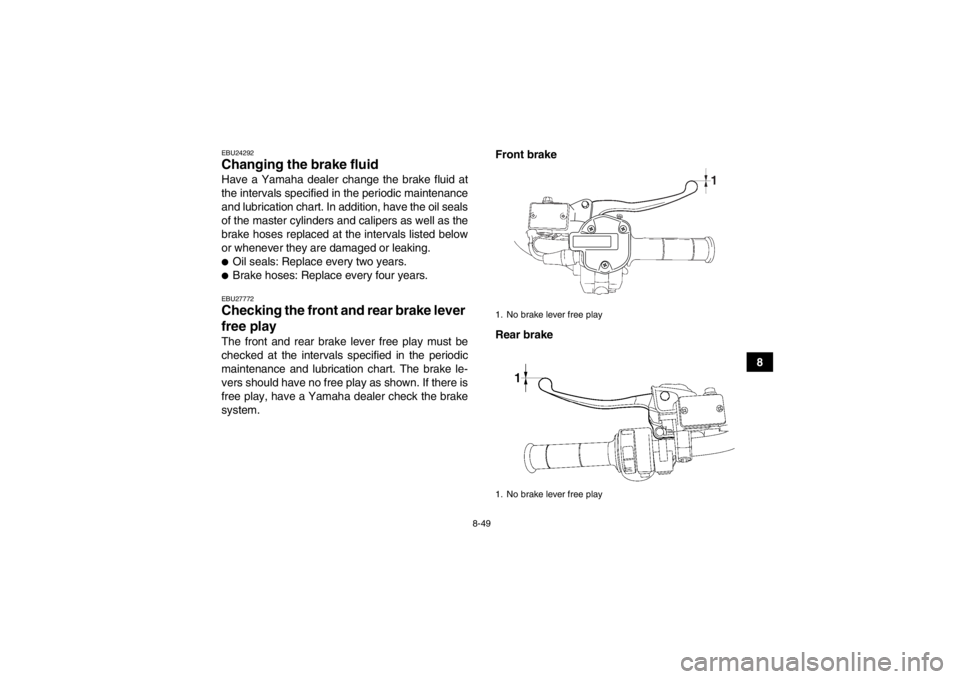
8-49
8
EBU24292Changing the brake fluid Have a Yamaha dealer change the brake fluid at
the intervals specified in the periodic maintenance
and lubrication chart. In addition, have the oil seals
of the master cylinders and calipers as well as the
brake hoses replaced at the intervals listed below
or whenever they are damaged or leaking.●Oil seals: Replace every two years.●Brake hoses: Replace every four years.EBU27772Checking the front and rear brake lever
free play The front and rear brake lever free play must be
checked at the intervals specified in the periodic
maintenance and lubrication chart. The brake le-
vers should have no free play as shown. If there is
free play, have a Yamaha dealer check the brake
system.Front brake
Rear brake
1. No brake lever free play
1. No brake lever free play
U2LB60E0.book Page 49 Thursday, March 21, 2013 10:20 AM
Page 142 of 174
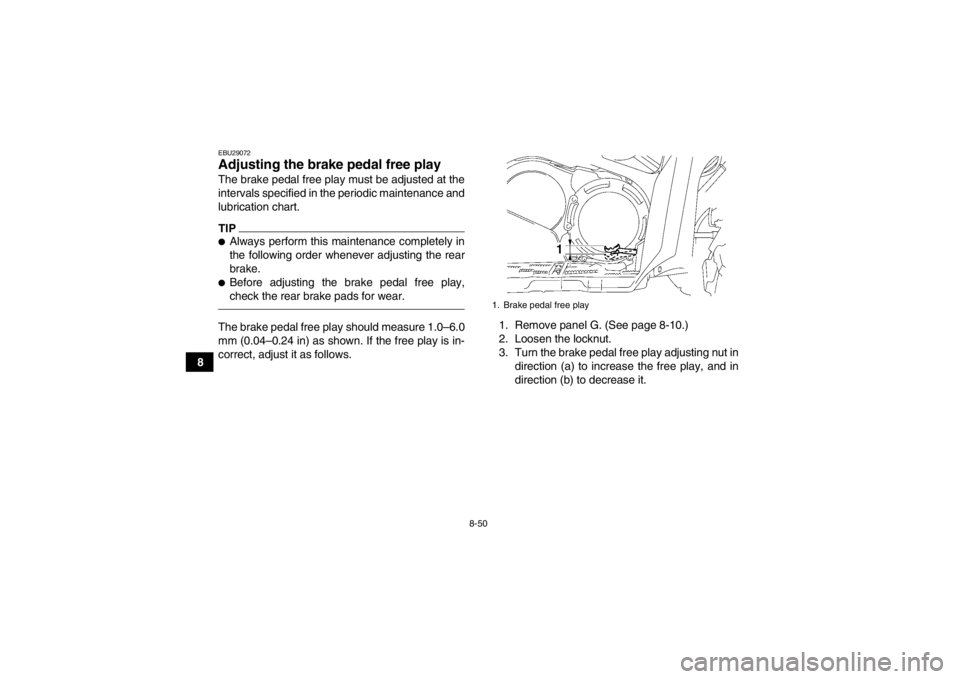
8-50
8
EBU29072Adjusting the brake pedal free play The brake pedal free play must be adjusted at the
intervals specified in the periodic maintenance and
lubrication chart.TIP●Always perform this maintenance completely in
the following order whenever adjusting the rear
brake.●Before adjusting the brake pedal free play,
check the rear brake pads for wear.The brake pedal free play should measure 1.0–6.0
mm (0.04–0.24 in) as shown. If the free play is in-
correct, adjust it as follows.1. Remove panel G. (See page 8-10.)
2. Loosen the locknut.
3. Turn the brake pedal free play adjusting nut in
direction (a) to increase the free play, and in
direction (b) to decrease it.
1. Brake pedal free play
U2LB60E0.book Page 50 Thursday, March 21, 2013 10:20 AM
Page 143 of 174
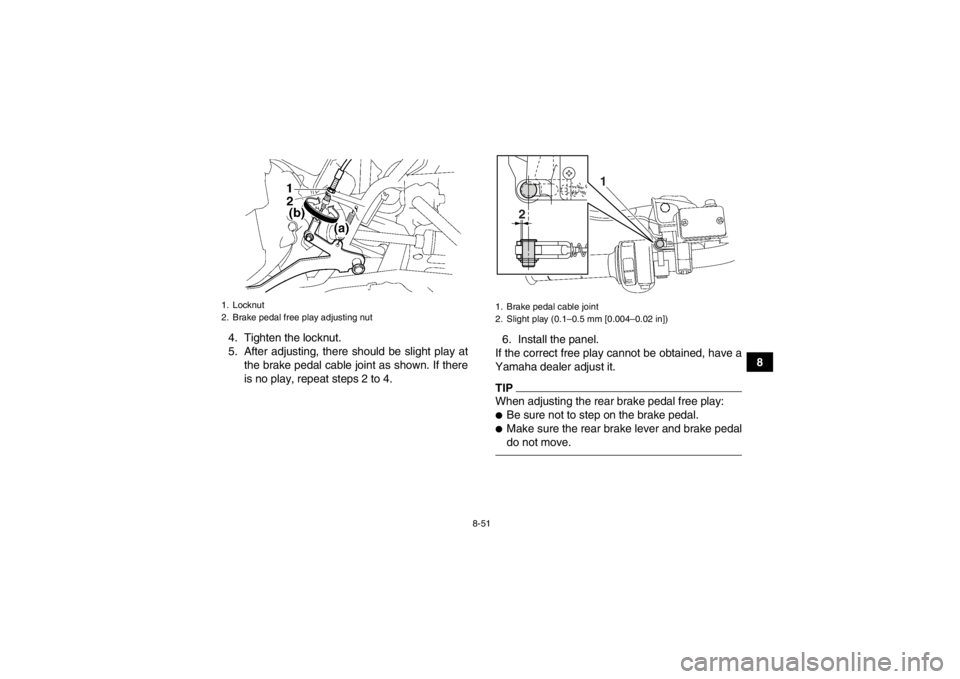
8-51
8
4. Tighten the locknut.
5. After adjusting, there should be slight play at
the brake pedal cable joint as shown. If there
is no play, repeat steps 2 to 4. 6. Install the panel.
If the correct free play cannot be obtained, have a
Yamaha dealer adjust it.
TIPWhen adjusting the rear brake pedal free play:●Be sure not to step on the brake pedal.●Make sure the rear brake lever and brake pedal
do not move.
1. Locknut
2. Brake pedal free play adjusting nut
1. Brake pedal cable joint
2. Slight play (0.1–0.5 mm [0.004–0.02 in])
1
2
U2LB60E0.book Page 51 Thursday, March 21, 2013 10:20 AM
Page 144 of 174
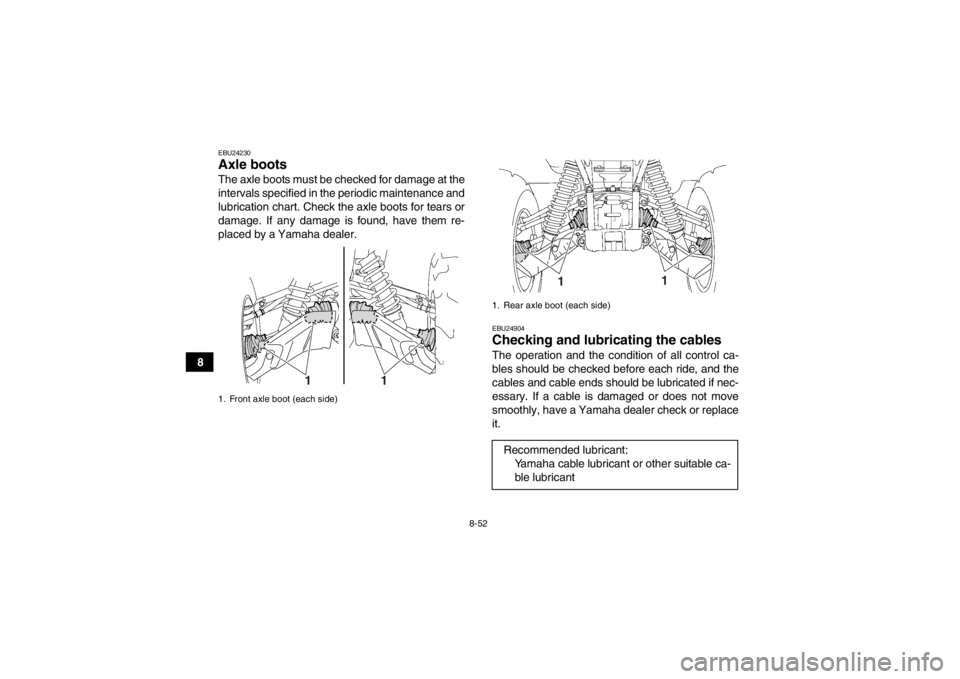
8-52
8
EBU24230Axle boots The axle boots must be checked for damage at the
intervals specified in the periodic maintenance and
lubrication chart. Check the axle boots for tears or
damage. If any damage is found, have them re-
placed by a Yamaha dealer.
EBU24904Checking and lubricating the cables The operation and the condition of all control ca-
bles should be checked before each ride, and the
cables and cable ends should be lubricated if nec-
essary. If a cable is damaged or does not move
smoothly, have a Yamaha dealer check or replace
it.
1. Front axle boot (each side)
1
1
1. Rear axle boot (each side)Recommended lubricant:
Yamaha cable lubricant or other suitable ca-ble lubricant
1
1
U2LB60E0.book Page 52 Thursday, March 21, 2013 10:20 AM
Page 145 of 174
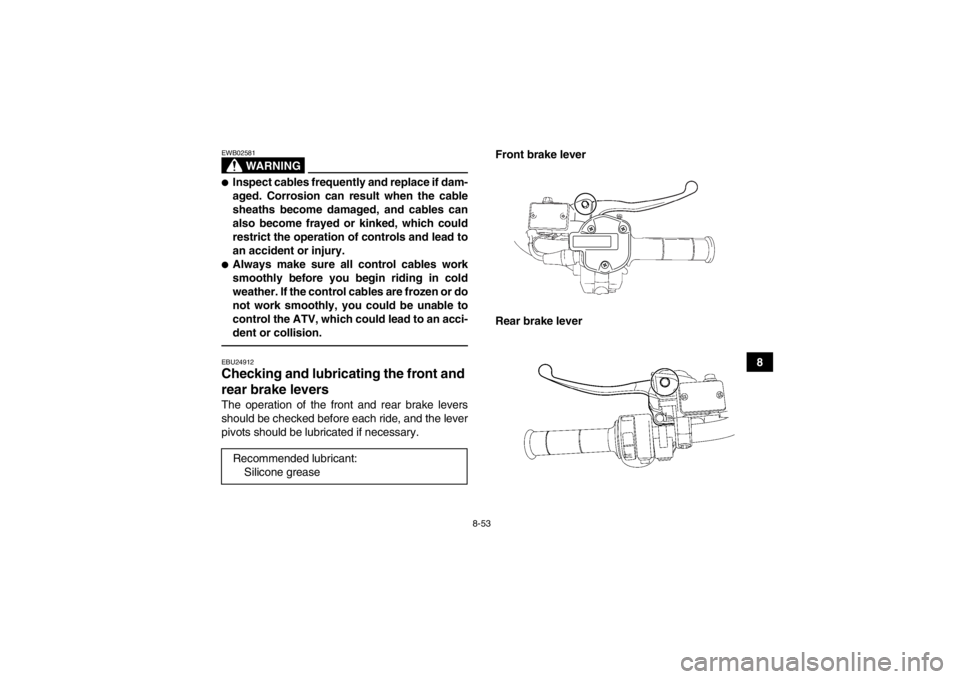
8-53
8
WARNING
EWB02581●Inspect cables frequently and replace if dam-
aged. Corrosion can result when the cable
sheaths become damaged, and cables can
also become frayed or kinked, which could
restrict the operation of controls and lead to
an accident or injury.●Always make sure all control cables work
smoothly before you begin riding in cold
weather. If the control cables are frozen or do
not work smoothly, you could be unable to
control the ATV, which could lead to an acci-
dent or collision.EBU24912Checking and lubricating the front and
rear brake levers The operation of the front and rear brake levers
should be checked before each ride, and the lever
pivots should be lubricated if necessary.Front brake lever
Rear brake lever
Recommended lubricant: Silicone greaseU2LB60E0.book Page 53 Thursday, March 21, 2013 10:20 AM
Page 146 of 174

8-54
8
EBU28832Checking and lubricating the brake
pedal The operation of the brake pedal should be
checked before each ride, and the pedal pivot
should be lubricated if necessary.TIPTo access the brake pedal pivot, remove panel G.
(See page 8-10.)
EBU24963Checking the wheel hub bearings The front and rear wheel hub bearings must be
checked at the intervals specified in the periodic
maintenance and lubrication chart. If there is play
in a wheel hub or if a wheel does not turn smoothly,
have a Yamaha dealer check the wheel hub bear-
ings.EBU25022Checking the stabilizer bushes The stabilizer bushes must be checked for cracks
or damage at the intervals specified in the periodic
maintenance and lubrication chart.
Have a Yamaha dealer replace the stabilizer bush-
es if necessary.
Recommended lubricant:
Lithium-soap-based grease
U2LB60E0.book Page 54 Thursday, March 21, 2013 10:20 AM
Page 147 of 174
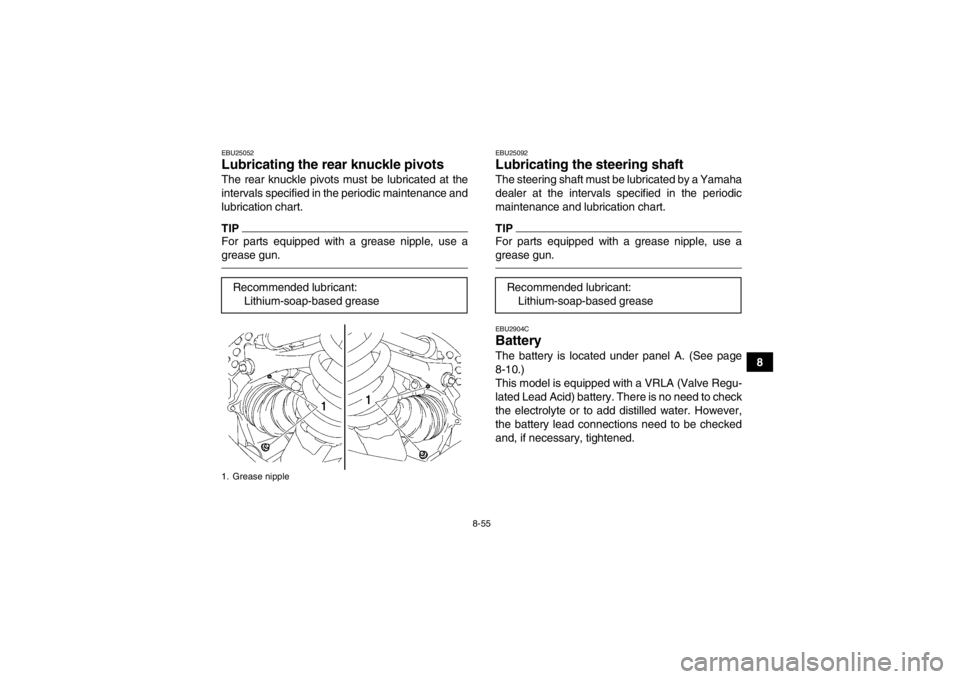
8-55
8
EBU25052Lubricating the rear knuckle pivots The rear knuckle pivots must be lubricated at the
intervals specified in the periodic maintenance and
lubrication chart.TIPFor parts equipped with a grease nipple, use a
grease gun.
EBU25092Lubricating the steering shaft The steering shaft must be lubricated by a Yamaha
dealer at the intervals specified in the periodic
maintenance and lubrication chart.TIPFor parts equipped with a grease nipple, use a
grease gun.EBU2904CBattery The battery is located under panel A. (See page
8-10.)
This model is equipped with a VRLA (Valve Regu-
lated Lead Acid) battery. There is no need to check
the electrolyte or to add distilled water. However,
the battery lead connections need to be checked
and, if necessary, tightened.
Recommended lubricant:
Lithium-soap-based grease
1. Grease nipple
Recommended lubricant:Lithium-soap-based grease
U2LB60E0.book Page 55 Thursday, March 21, 2013 10:20 AM
Page 148 of 174

8-56
8
WARNING
EWB02160Battery electrolyte is poisonous and danger-
ous, as it contains sulfuric acid, which can
cause severe burns. Avoid contact with skin,
eyes or clothing. Always shield your eyes
when working near batteries.
Antidote:
EXTERNAL: Flush with water.
INTERNAL: Drink large quantities of water or
milk. Follow with milk of magnesia, beaten egg
or vegetable oil. Call a physician immediately.
EYES: Flush with water for 15 minutes and get
prompt medical attention.
Batteries produce explosive gases. Keep
sparks, flame, cigarettes or other sources of ig-
nition away. Ventilate when charging or using
in an enclosed space.
KEEP OUT OF REACH OF CHILDREN.NOTICEECB00620Never attempt to remove the battery cell seals,
as this would permanently damage the battery.
To remove the battery1. Remove panel A. (See page 8-10.)
2. Remove the front carrier by removing the bolts.1. Carrier bolt (under the fenders)
U2LB60E0.book Page 56 Thursday, March 21, 2013 10:20 AM
Page 149 of 174
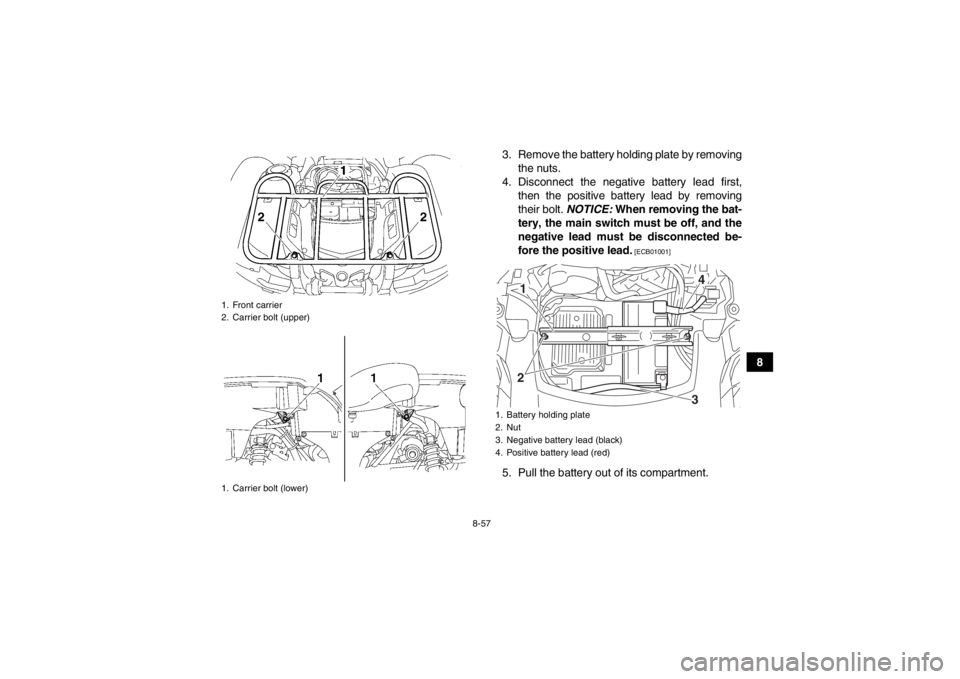
8-57
8
3. Remove the battery holding plate by removing
the nuts.
4. Disconnect the negative battery lead first, then the positive battery lead by removing
their bolt. NOTICE: When removing the bat-
tery, the main switch must be off, and the
negative lead must be disconnected be-
fore the positive lead.
[ECB01001]
5. Pull the battery out of its compartment.
1. Front carrier
2. Carrier bolt (upper)
1. Carrier bolt (lower)
1. Battery holding plate
2. Nut
3. Negative battery lead (black)
4. Positive battery lead (red)
12
43
U2LB60E0.book Page 57 Thursday, March 21, 2013 10:20 AM
Page 150 of 174
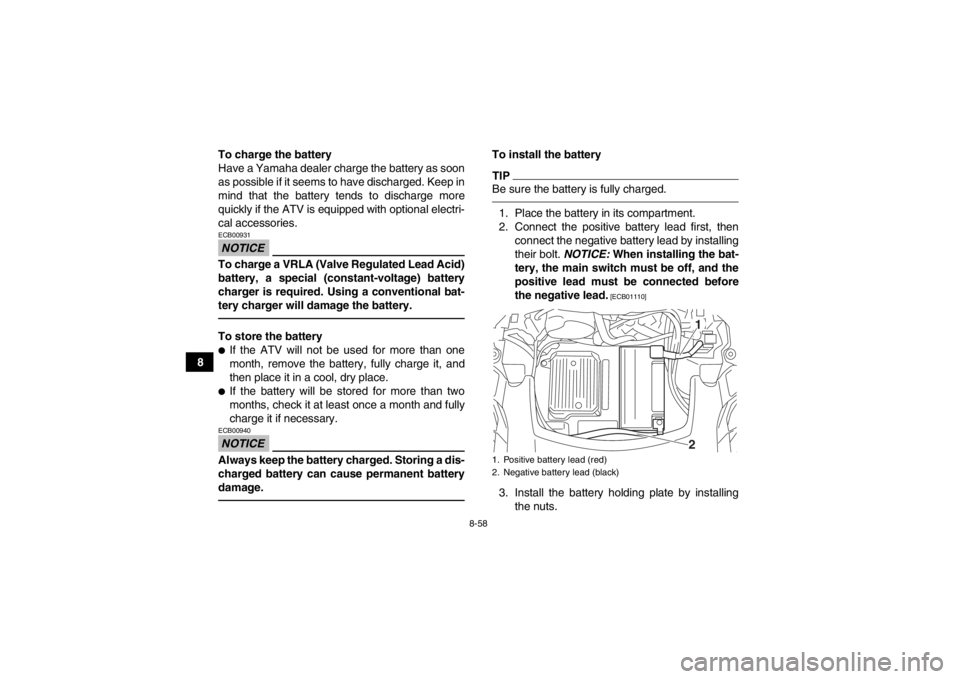
8-58
8To charge the battery
Have a Yamaha dealer charge the battery as soon
as possible if it seems to have discharged. Keep in
mind that the battery tends to discharge more
quickly if the ATV is equipped with optional electri-
cal accessories.
NOTICEECB00931To charge a VRLA (Valve Regulated Lead Acid)
battery, a special (constant-voltage) battery
charger is required. Using a conventional bat-
tery charger will damage the battery.To store the battery●If the ATV will not be used for more than one
month, remove the battery, fully charge it, and
then place it in a cool, dry place.●If the battery will be stored for more than two
months, check it at least once a month and fully
charge it if necessary.NOTICEECB00940Always keep the battery charged. Storing a dis-
charged battery can cause permanent battery
damage.
To install the batteryTIPBe sure the battery is fully charged.1. Place the battery in its compartment.
2. Connect the positive battery lead first, then
connect the negative battery lead by installing
their bolt. NOTICE: When installing the bat-
tery, the main switch must be off, and the
positive lead must be connected before
the negative lead.
[ECB01110]
3. Install the battery holding plate by installing the nuts.1. Positive battery lead (red)
2. Negative battery lead (black)
12
U2LB60E0.book Page 58 Thursday, March 21, 2013 10:20 AM